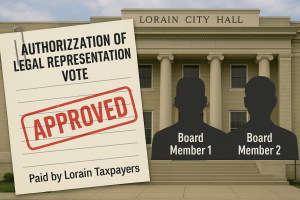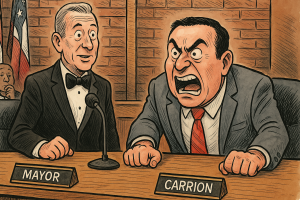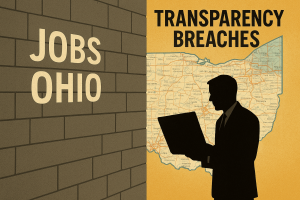One Rule for Them: The Unjust Prosecution of Garon Petty
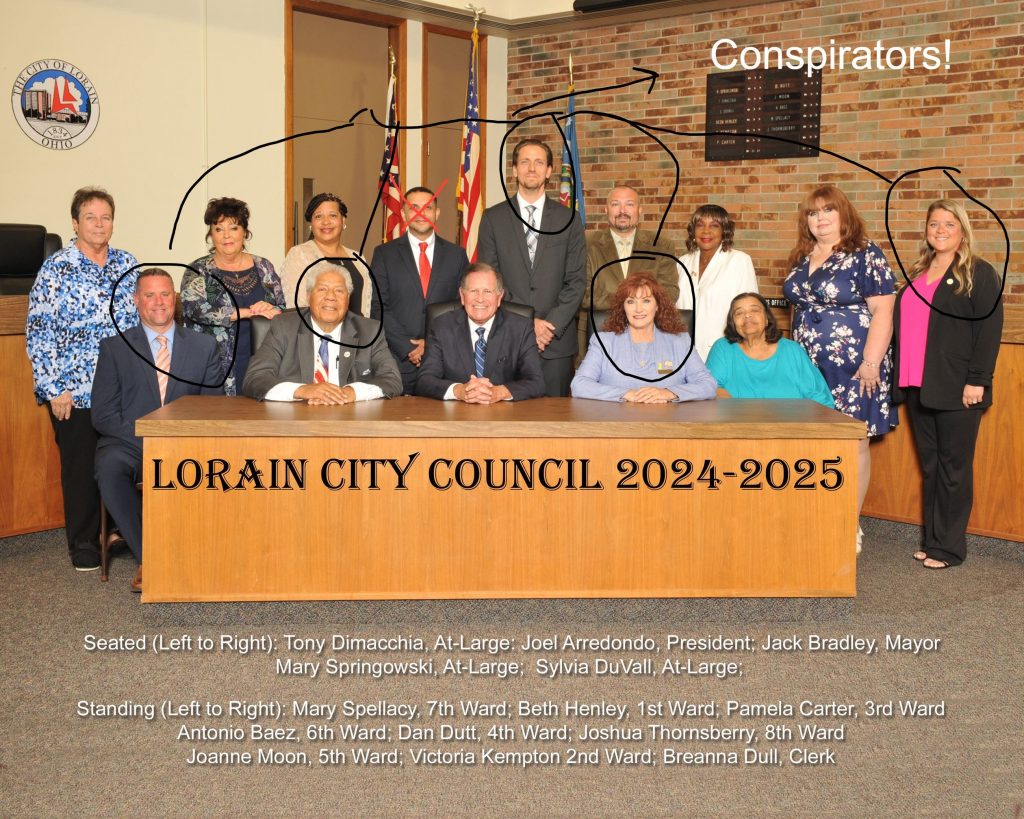
How Lorain Officials Turned a Routine Council Meeting Into a Weaponized Show Trial Against a Political Critic
May 14, 2025
Written by Aaron Knapp
Aaron Knapp is a journalist, government transparency advocate, and candidate for Lorain City Council (Ward 6). He has reported extensively on political misconduct, civil rights violations, and public corruption across Northeast Ohio.
Thanks for reading Aaron’s Substack! Subscribe for free to receive new posts and support my work.
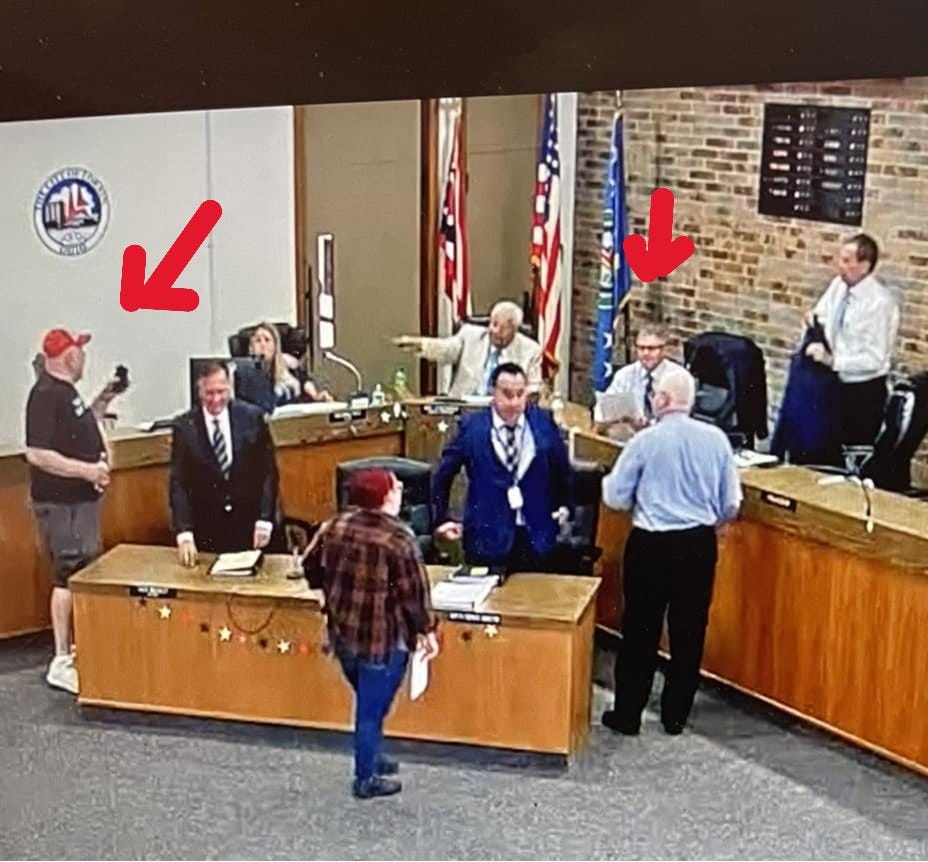
“All meetings of any public body are declared to be public meetings open to the public at all times.” — Ohio Revised Code 121.22(C)
On July 1, 2024, Garon Petty stood on the public floor of Lorain City Council chambers just as the motion to adjourn was underway. He did not menace. He did not threaten. He did not approach within ten feet of any councilmember. He was loud—witnesses confirmed that his voice carried—but no one present could recall or repeat a single word he said. The Clerk had already shut off the public chamber camera before the interaction, ensuring no visual or audio record. And while some officials later claimed to feel unsettled, no panic or distress was visible in the footage preceding the moment.
The prosecution that followed—on charges of aggravated trespass, menacing, and intimidation of a public servant—was not based on objective facts. It must also be understood in context: Petty has a long and contentious history with Lorain City Council and the Lorain Police Department. He has spoken out at numerous meetings about ADA violations, police misconduct, and city transparency failures. His advocacy has made him a persistent critic—and a frequent target.
This most recent incident did not occur in a vacuum. It came after months, even years, of friction, complaints, and public exposure of city practices. Petty’s presence has often disrupted the status quo—not because he breaks laws, but because he challenges power. The charges filed against him are best understood as retaliation disguised as law enforcement.
The evidence, the timeline, and the internal communications all reveal a disturbing truth: this prosecution was political, retaliatory, and constitutionally indefensible.
A Meeting That Wasn’t Lawfully Closed
Under Lorain Ordinance 1171.01(a)(5), council meetings must be adjourned by the presiding officer following a formal motion. The gavel is symbolic, not legally operative. The meeting ends when the adjournment motion is made and passed—not when the gavel strikes. In fact, State ex rel. Long v. Cardington Village Council, 92 Ohio St.3d 54 (2001), reaffirmed that a meeting remains open and subject to public access until properly adjourned by vote, regardless of traditional gestures like a gavel.
On July 1, 2024, the motion to adjourn had just occurred when Garon Petty moved toward the dais. He did not rush the floor before the motion. He entered the space during adjournment, a moment still recognized as part of the public proceeding. Councilmembers and staff—including the Clerk—remained seated and conversing. No dispersal notice or restriction was announced.
City testimony also confirms the routine nature of post-meeting movement. In internal communications and in sworn testimony, Lt. Jacob Morris stated that Clerk Breanna Dull shuts off the camera quickly because “she is used to the routine.” That same routine was familiar to Petty. He, too, had attended numerous prior sessions and knew that the gavel did not end the meeting—adjournment did. He engaged during a customary window of interaction that had never previously drawn police action.
Moreover, ORC 121.22(C) declares that public meetings are “open to the public at all times.” The city provided no legal justification for closing access to the council floor in that window. Without a formal executive session or adjournment declaration followed by exit, the space remained a public forum under Ohio law.
Petty’s timing, like his behavior, fell squarely within protected norms. The city’s decision to criminalize that moment contradicts decades of practice, relevant statutes, and the Ohio Supreme Court’s precedent..

Longstanding Tradition Violated
In Lorain, approaching the dais after a city council meeting has long been a customary and constitutionally protected act of civic engagement. For decades, residents have walked up to speak with councilmembers, offer feedback, or seek clarification on public matters after the gavel has dropped—without legal repercussion. There is no rule or ordinance in Lorain that prohibits this conduct. In fact, it has been a routine feature of local democracy.
Throughout 2023 and 2024, numerous individuals—including political candidates, activists, and journalists—spoke directly with officials in the chamber after adjournment. These interactions were not only tolerated but often welcomed. No one was cited, warned, or prosecuted.
In a highly visible incident in February 2025, Tia Hilton, a known political figure, yelled across the chamber during a live meeting, disrupting council proceedings. She was gaveled down for her outburst but faced no criminal charges. The contrast is glaring.
Garon Petty, by comparison, did raise his voice—he is known for having a naturally loud tone, and multiple witnesses acknowledged that his voice carried. But despite being loud, not one person could say what he actually said. No quote. No threat. No transcribable record. He asked questions. He attempted engagement. And yet, his conduct was treated as criminal simply because it made certain individuals uncomfortable.
He did not shout obscenities. He did not make threats. He did not ignore directives. He complied immediately when told to leave. His only distinguishing features? His prior criticism of council, his political outsider status, and his physical presence.
This selective criminalization of routine civic behavior creates a dangerous precedent. It sends the message that constitutional rights are reserved only for those who agree with the majority—or who look or sound a certain way. Petty’s actions mirrored those of countless others, but he alone was targeted.
What was once a protected and recurring tradition is now being weaponized as criminal conduct—not because the act changed, but because the person did. His prior criticism of council, his political outsider status, and his imposing physical stature.
This selective criminalization of routine civic behavior creates a dangerous precedent. It sends the message that constitutional rights are reserved only for those who agree with the majority—or who look a certain way. Petty’s actions mirrored those of countless others, but he alone was targeted.
What was once a protected and recurring tradition is now being weaponized as criminal conduct—not because the act changed, but because the person did
The Evidence Delivery Was Unlawful
To date, the defense in State v. Petty (Case No. 2024CRB02378) has not received the full set of audio recordings from councilmember interviews or the digital files referenced in the affidavit and complaints. Yet long before charges were even filed, Captain Jacob Morris of the Lorain Police Department hand-delivered those same materials—including audio interviews, emails, and documents—to journalist Aaron Knapp. This delivery occurred outside of any formal legal process, breaking the chain of custody and tainting the evidentiary trail.
When asked why the evidence was given to the press, Capt. Morris replied, “Chief told me to give it to you… we [he] know you will put it online.” The statement implies not just disregard for due process, but an intentional weaponization of evidence to control public narrative. This act likely violates Ohio Revised Code 2921.12(A)(1), which prohibits the tampering with evidence when someone “alters, destroys, conceals, or removes any record, document, or thing, with purpose to impair its value or availability as evidence in such proceeding or investigation.”
Furthermore, the public release of investigatory materials before they are logged into official record may also implicate ORC 149.43(A)(1)(h), which limits public disclosure of records when a specific investigatory process is ongoing and compromised by premature dissemination.
To this day, Petty’s attorney has received no formal copy of those recordings through discovery. There is no court filing that logs the digital evidence as properly submitted, and the prosecution has failed to disclose or certify these materials as required by law under Ohio Criminal Rule 16 and the due process guarantees of the Ohio and U.S. Constitutions.
More alarmingly, Judge James Kimbler—the sitting judge on the case—has personally corresponded via email with Knapp and offered legal interpretation of the pending criminal matter. This crosses a critical judicial ethics line under Ohio Code of Judicial Conduct, Rule 2.9, which prohibits ex parte communications outside authorized exceptions. It also raises grave questions about impartiality.
Further complicating matters, the entire Lorain Law Department is a witness in the case. Internal emails and complaints show they helped coordinate statements, reviewed council testimony, and advised on the charging decision. Under standard ethical rules, a prosecutor who is a fact witness must recuse and refer the case to an independent authority.
This leaves a troubling question: How is this case even still being tried?
Ohio’s rules of evidence are clear. Under Rule 802, hearsay—defined as an out-of-court statement offered to prove the truth of the matter asserted—is inadmissible unless it meets an exception. The statements provided by the Clerk of Council and others contain no direct quotes, no spontaneous remarks, and no contemporaneous documentation. They are post-hoc claims, based on impressions, and made under political pressure.
No physical evidence. No verified recording. No contemporaneous reports. The prosecution’s case is built entirely on opinion, feeling, and inference. That’s not just a weak case—it’s a constitutional problem.
When evidence is concealed from the defense, leaked to the press, and advanced by conflicted city staff in coordination with a judge who has provided off-record legal advice, there is no longer a presumption of fairness. There is only power masquerading as prosecution.
Adding another layer of concern, the City of Lorain appointed an “independent prosecutor” to handle the case after these conflicts were raised. But records show that the individual appointed is the same attorney the city routinely uses for civil matters, including advising Council and representing the Mayor’s office. This raises serious questions about independence. An independent prosecutor is supposed to be neutral, without ties to any party or previous involvement in the underlying incident. Here, the appointee is not only not independent, but effectively embedded in the same political ecosystem that manufactured the charges.
If the city now concedes that its law department is conflicted—requiring outside counsel—then by that logic, the conflict existed at the time charges were filed. That would make the original filing fatally defective. Any action tainted by conflict cannot be cured retroactively with a new face. The process must restart under true, impartial review. Anything less is a constitutional sham.
This principle is affirmed in Ohio case law. In State ex rel. Mason v. Burnside, 100 Ohio St.3d 162, 2003-Ohio-5350, ¶ 21, the Ohio Supreme Court held that prosecutorial actions must not only be free from conflict but must also avoid the appearance of impropriety. Similarly, in State v. Keenan, 66 Ohio St.3d 402 (1993), the Court emphasized that when the integrity of the prosecution is compromised by bias or improper motive, dismissal or reversal is appropriate.
Moreover, under Ohio Rules of Professional Conduct Rule 3.7, a lawyer shall not act as an advocate at a trial in which the lawyer is likely to be a necessary witness unless certain narrow exceptions apply. Here, members of the Law Department not only coordinated the evidence but were direct participants in the fact pattern—disqualifying them from prosecuting.
Thus, the original charging decision was fundamentally flawed. Continuing the case without a full reset violates the defendant’s right to an impartial tribunal and a fair process as guaranteed by the Sixth and Fourteenth Amendments.
Violating Discovery Obligations
Under Ohio Criminal Rule 16(B)(1)(a)(ii), the prosecution is required to provide the defense with “any written or recorded statement by a witness or co-defendant” and “documents, tangible objects, reports, or statements” that are relevant to the case. This includes body-worn camera videos, written affidavits, and internal city correspondence. These are not discretionary items—they are mandatory.
The docket confirms Petty’s attorney, Robert J. Gargasz, filed a timely Demand for Discovery and a Motion for Production of Record in Support of Motion to Dismiss and for Acquittal on September 17 and October 11, 2024, respectively. However, to date, full compliance has not occurred. Though more than 40 subpoenas have been issued and a Bill of Particulars was filed by the prosecution on October 24, 2024, the original set of audio files and digital materials shared with the press remain unreceived by the defense.
This violates both Crim.R. 16(D) (timeliness) and the spirit of fairness guaranteed under the Sixth Amendment to the U.S. Constitution. When a city leaks evidence to journalists but obstructs a defendant’s right to obtain the same, it ceases to be a neutral government actor. It becomes a hostile party engaging in procedural sabotage.
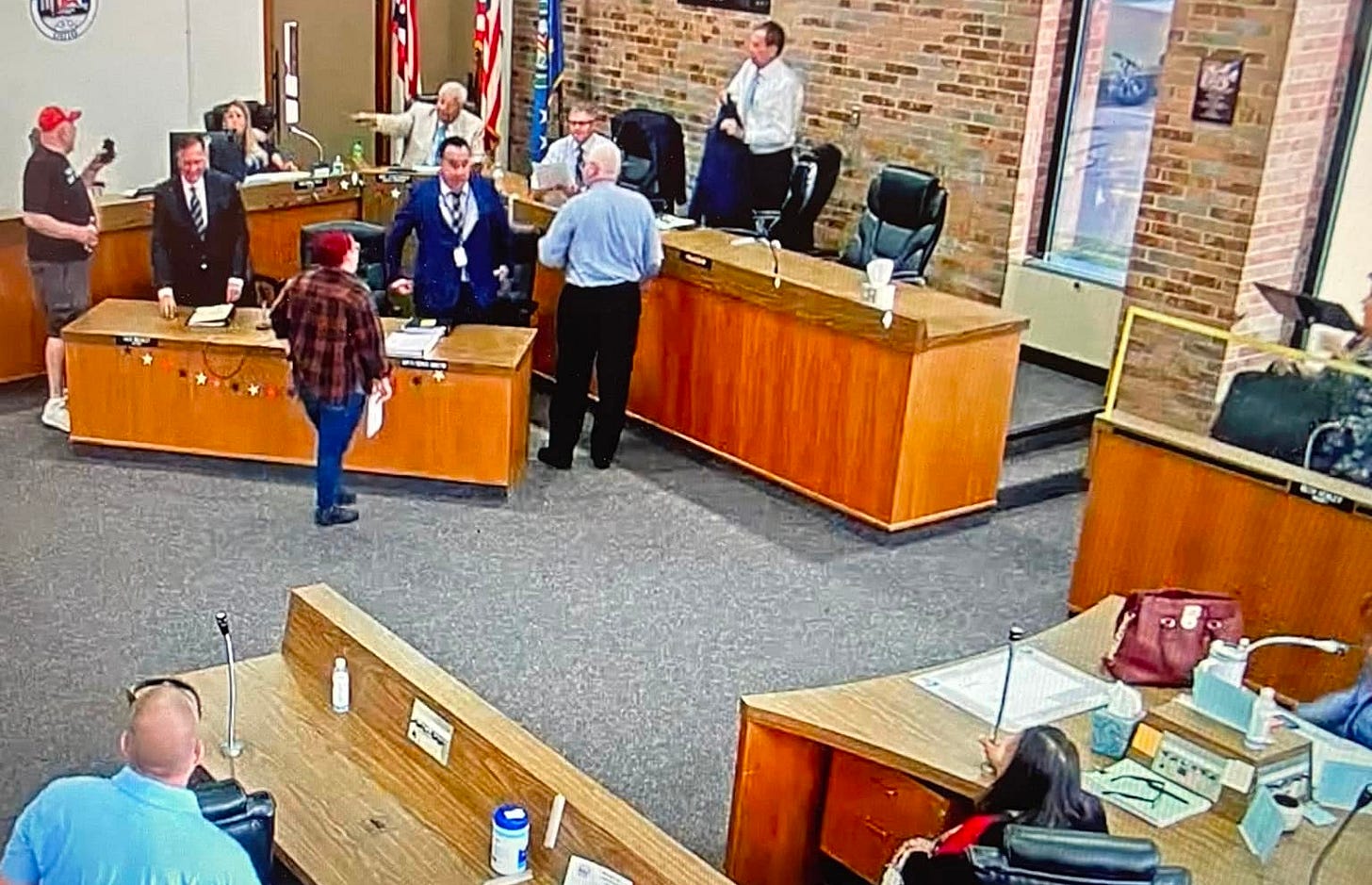
Intimidation and Menacing Charges Don’t Hold
To prosecute for intimidation under ORC 2921.03, the State must show the defendant knowingly and by force or unlawful threat attempted to influence a public servant. Menacing under ORC 2903.22 requires proof that the defendant knowingly caused another to believe that they would suffer physical harm. In Garon Petty’s case, there is no video or audio record of any threat—verbal or otherwise. No officer, witness, or complainant has stated exactly what Petty said, because none can recall anything he actually said at all.
Notably, there were no uniformed officers present during the incident—only councilmembers, staff, and citizens. Compounding the problem, the Clerk of Council manually shut off the Council Chamber camera just before the moment in question, leaving a deliberate blind spot in the official record. The city’s own footage, which ends before Petty walks forward, shows no signs of panic, distress, or alarm from anyone in the gallery or among councilmembers.
The affidavit and witness statements are also telling in their vagueness. None cite a direct threat. None quote Petty verbatim. The Clerk stated she “felt unsafe,” but her reaction is not corroborated by any spontaneous verbal reaction on video nor supported by surrounding individuals.
Ohio courts have made clear that subjective fear is not a substitute for criminal evidence. In State v. Baker, 2009-Ohio-1296, the court ruled that ambiguous presence or non-verbal conduct cannot meet the legal standard for menacing. The same holds true here.
Furthermore, in City of Houston v. Hill, 482 U.S. 451 (1987), the U.S. Supreme Court held that even offensive speech toward public officials in open forums is protected by the First Amendment. Public officials are expected to tolerate more—not less—scrutiny.
If no words were spoken, if no threat was issued, and if no one can say what Petty said, then how can he be prosecuted for intimidation? The answer is simple: he can’t—not under the law. He is being prosecuted for making people uncomfortable, not for breaking the law. And that is not justice. That is retaliation. , meaning the crucial moments in question were deliberately left undocumented. The city’s own footage offers no signs of distress or alarm from anyone on the council floor or in the gallery. Petty was not yelling, moving aggressively, or disrupting any process. He stood in place. He asked to speak. And then he complied when asked to leave.
Even Mayor Jack Bradley, who was physically closest to the incident, is later quoted as saying, “I didn’t see Garon do anything that rose to the level of a crime.” That statement from Lorain’s chief executive directly contradicts the charges of intimidation and menacing, which rely on the premise that Petty knowingly caused fear.
If the city’s case rests on subjective discomfort, that’s not enough. Ohio courts have consistently ruled that mere presence or silence cannot constitute menacing unless accompanied by words or actions intended to threaten. In State v. Baker, 2009-Ohio-1296, the court held that ambiguous gestures or unspoken presence alone do not satisfy the statutory burden.
Further, public officials are expected to endure a higher threshold of scrutiny and engagement in public forums. That expectation is baked into the Constitution and clarified in rulings like City of Houston v. Hill, 482 U.S. 451 (1987), which struck down laws criminalizing offensive speech toward public officials in open forums.
The affidavit and complaints in this case fail to cite any threatening quote, and none of the witness statements contain direct claims that Petty made a threat. The Clerk simply claimed she “felt unsafe.” Feelings, however, are not facts. And selective fear, especially when it’s not shared by others in the room, is not enough to incarcerate a person.
The intimidation and menacing charges appear to be political tools, not legal claims. They serve as cover for silencing dissent, not as responses to criminal behavior. And in a democracy, that’s a far more dangerous offense.
No Trespass Warning Was Issued
To sustain a conviction for criminal trespass under ORC 2911.21(A)(1), the prosecution must prove that the individual “knowingly entered or remained on the land or premises of another without privilege to do so.” For aggravated trespass under ORC 2911.211(A), there must be an intent to commit a misdemeanor involving physical harm or the threat thereof. These standards are not met in this case.
Garon Petty entered the council floor during a public meeting, acting in his capacity as an independent journalist and public watchdog. While signs were posted near the council dais, they lacked reference to any specific ordinance or statute, as required for enforceability. Moreover, courts have held in cases like State v. Newell, 105 Ohio App.3d 39 (1995) that signage must either cite law or be paired with clear, prior notice for a trespass conviction to hold. The vague signs alone were not legally sufficient.
More importantly, Petty complied immediately when instructed to leave. He did not argue. He did not linger. He did not return. Under ORC 2911.21(A)(4), a person can only be guilty of trespass if they “negligently fail or refuse to leave upon being notified to do so.” That condition was not met.
Further undermining the credibility of the charge is the fact that Petty was the only individual asked to leave. Others, including Chronicle-Telegram reporter Carissa Woytach, remained on the council floor after the meeting ended and were not instructed to exit. If the space was restricted, it was not done so uniformly. That constitutes selective enforcement and raises equal protection concerns under both Ohio law and the Fourteenth Amendment.
In sum, Petty’s compliance, his role as a journalist, the absence of cited law on signage, and the inconsistent application of removal orders all show that the city’s claim of criminal trespass was both factually hollow and legally unsustainable.
Who Wrote the Reports, and When?
The police report in Garon Petty’s case was not filed immediately following the July 1, 2024 incident. Instead, it was authored days later by Lt. Jacob Morris, well after Lorain City Council members and legal advisors had already discussed how to respond to the event. This delay is critical because it shows the narrative wasn’t documented in real time—it was constructed after the fact.
Internal city emails reveal that Chief James McCann initially advised against pursuing charges, cautioning that the police do not enforce council rules and that criminal enforcement of procedural norms might backfire. In one email, McCann plainly stated, “The police don’t enforce council rules… they are most likely getting arrested or getting a summons”—implying that Council’s desire to eject or silence Petty lacked legal foundation.
But that tone shifted dramatically within days. After continued correspondence among councilmembers and city staff, McCann later issued a directive to Lt. Morris that was far more blunt: “Make it happen.” That email, now part of the public record, flipped the department’s position from hesitant to aggressive, signaling that political pressure—not new evidence—had driven the change.
Morris then authored the affidavit and criminal complaints, incorporating vague language about discomfort and fear, but offering no concrete threat, no disorder, and no legal breach that had not occurred in previous council sessions involving other citizens.
Also troubling is that several of the councilmembers who influenced the decision are themselves the ones who submitted witness statements. This creates an ethical conflict: individuals who shaped the charge narrative are the same ones being treated as neutral victims or observers. In real-world legal standards, such a confluence would normally disqualify their testimony or require an independent review.
There is no indication in the record that any officer observed Petty engaging in threatening or disruptive behavior during the July 1 meeting. Instead, the only action taken was that Petty stood quietly, asked to speak, and then complied immediately when told to leave. The escalation to criminal charges occurred only after Council and city officials coordinated behind closed doors.
This pattern aligns with what civil rights attorneys often call a “reverse-engineered prosecution”—where officials begin with a political goal, then construct the paperwork and narrative needed to justify it.
Taken together, the report timing, the change in tone from McCann, and the internal pressure campaign reveal a chilling truth: this was not a police-led investigation. It was a Council-directed retaliation, laundered through law enforcement channels to give it legal cover.
The police report was authored by Lt. Jacob Morris days after the incident, and only after the Mayor’s office and City Council had already begun discussing a possible charge. Internal emails confirm that the Clerk of Council originally said she would not pursue charges—but changed course after discussions with legal counsel and high-ranking city staff. This sequence is critical. It shows that the complaint was not immediate, nor spontaneous. It was constructed. And it was coordinated.
Council Broke Their Own Rules
Lorain City Council didn’t just overreact—they broke their own rules codified in local ordinance. According to 1171.01(a)(3), all regular, special, emergency, and committee meetings of the legislative authority must be “open to the public and conducted in accordance with O.R.C. 121.22.” That includes periods before and after formal agenda items when no lawful adjournment has taken place. The floor remains public unless otherwise noticed.
Council also violated 1171.01(a)(5) by failing to follow prescribed adjournment procedure. There is no indication that President Joel Arredondo or the President Pro Tempore officially gaveled the meeting to a close. Video footage and eyewitnesses confirm that councilmembers and staff were still discussing city business when Petty approached.
More importantly, 1171.01(a)(7) demands that all resolutions and ordinances go through three separate readings unless waived by a three-fourths vote—yet the actions taken that night, including alleged motions or declarations made after adjournment, were never formally codified. If they claim rules were in effect at that moment, those rules were never lawfully enacted.
Finally, there is the matter of access. ORC 121.22(C) guarantees that public meetings are open at all times, and ORC 2921.45 prohibits public officials from knowingly depriving a person of rights under color of law. By criminalizing post-meeting floor access—something regularly granted to others—they deprived Petty of a right held by all others.
“The public body shall not hold an executive session unless the motion specifically states the purpose and the body votes by roll call.” — ORC 121.22(G)
“No public servant, under color of law or office, shall knowingly deprive… any person of a constitutional or statutory right.” — ORC 2921.45(A)
In short, Council skipped procedure, suspended precedent, and chose to weaponize discomfort into criminal charges. They not only failed to follow their own laws—they used broken process to break a citizen’s spirit.
Council’s Internal Conflict of Interest
Multiple councilmembers who submitted statements in support of the prosecution are not neutral actors. They are entangled in ongoing lawsuits, political vendettas, or previous conflicts involving Garon Petty. Councilmember Mary Springowski, for instance, stated publicly during a November 7, 2022 council meeting, “Mr. Petty has made it clear he is against my reelection and has gone out of his way to politically target me.” That admission alone calls her impartiality into question.
In that same statement, Springowski went further, telling the public she was “tired of being threatened”—even though there was no credible evidence presented that Petty had ever made a threat. These kinds of broad, emotionally charged statements were later submitted to police as factual support for charges. Other councilmembers have appeared in email chains coordinating behind the scenes to manage public criticism and discredit dissenters.
Several of the statements submitted to police were made by individuals who were both complainants and adjudicators—councilmembers who have access to legal staff, police command, and court officers. In any other legal context, such overlapping roles would constitute a clear conflict of interest and would disqualify them from participating in criminal accusations.
Moreover, Clerk of Council Breanna Dull initially told investigators she did not want to pursue charges. This decision changed only after a string of high-level conversations involving the Mayor, Law Director, and council allies. Her reversal fits a larger pattern: Petty’s criticisms about ADA compliance, police behavior, and institutional transparency were not tolerated—they were punished.
Council emails, recorded statements, and meeting minutes all paint the same picture. The decision to criminalize Petty’s conduct was not rooted in law, but in longstanding animosity and a desire to silence dissent. His presence in council chambers became a political inconvenience, and the rules were selectively enforced to remove him.
As the saying goes: if you want to know who holds power, see who you’re not allowed to criticize. In Lorain, those who raise uncomfortable truths are punished, while others who behave disruptively—but align politically—face no consequence.
This is not conjecture—it is a pattern. The record is clear, and council’s own words prove it..
Targeting Dissent Through Procedure
From the delivery of evidence to a journalist instead of the defense, to the use of vague accusations in lieu of legal standards, this case was designed to intimidate—not adjudicate. The rules in Chapter 1171 of the Lorain Codified Ordinances exist to protect public access and provide checks on government overreach. Instead, they were used as a weapon.
But Garon Petty is far from the first target. Over the past several years, Lorain officials have turned city resources against a long list of perceived enemies: investigative journalist Aaron Knapp, former council member Dennis Flores, former city Human Resources director Linda Rivera, former Safety-Service Director Sanford Washington, and police officers Corey Middlebrooks and Miguel Baez. Each one raised uncomfortable questions. Each one faced retaliation—through firings, false accusations, harassment, or blocked access to records and meetings.
The pattern is unmistakable. Anyone who challenges the city’s leadership is suddenly labeled a threat, a disruptor, or unhinged. Petty’s treatment follows this same arc: public criticism is reframed as aggression, dissent is rebranded as danger. What the city cannot tolerate is not criminality—but contradiction.
Specific instances underscore this pattern:City of Lorain+2Justia Law+2Justia Dockets & Filings+2
- Police Chief Jim McCann’s Directive: In an internal communication, Police Chief Jim McCann instructed subordinates to “make it happen” concerning actions against Garon Petty. This directive suggests a proactive approach to targeting a specific individual, potentially bypassing standard procedures. Facebook
- Councilmember Mary Springowski’s Public Statements: Councilmember Mary Springowski has publicly expressed her adversarial stance toward Garon Petty. In a November 7, 2022, council meeting, she stated, “Mr. Petty has made it clear he is against my reelection and has gone out of his way to politically target me.” Such statements highlight a personal bias that may influence official actions. Facebook
- Councilman Tony Dimacchia’s Conduct: Councilman Tony Dimacchia has faced legal issues that raise questions about his judgment. He was convicted on a drunk driving charge and issued a public apology, acknowledging his mistake. While personal conduct does not directly relate to policy decisions, it contributes to the broader context of accountability among city officials.
When a government begins criminalizing the personalities and politics of its critics rather than their actions, it abandons law and embraces authoritarianism. The law was not applied uniformly; it was manipulated to serve a narrative: that only loyalists deserve full rights—and critics must be punished until they’re silent.
These instances collectively underscore concerns about the impartiality of certain city officials and suggest a pattern of targeting individuals who challenge the status quo. Such actions may undermine public trust and the principles of transparent governance.
Justice Delayed Is Retaliation Sustained
Adding further insult to injury, Garon Petty’s trial has now been continued until October 2025—more than 15 months after the initial incident. This extended delay is not just inconvenient—it is a violation of the right to a speedy trial, as protected under the Sixth Amendment to the U.S. Constitution, Article I, Section 10 of the Ohio Constitution, and Ohio Revised Code 2945.71(C)(1), which mandates that misdemeanors must generally be brought to trial within 90 days of arrest or summons.
In State v. Bonarrigo, 62 Ohio St.2d 7 (1980), the Ohio Supreme Court held that “undue delay which prejudices the defense” may be grounds for dismissal. Likewise, in Barker v. Wingo, 407 U.S. 514 (1972), the U.S. Supreme Court identified four factors to assess whether a delay violates the Sixth Amendment: the length of delay, the reason for the delay, the defendant’s assertion of the right, and prejudice to the accused. Here, each of these weighs in Petty’s favor. A 15-month delay is presumptively prejudicial, especially in a misdemeanor case with no physical harm and no tangible evidence.
Continuing this case—already built on faulty procedure, missing discovery, conflicting witnesses, and politically motivated testimony—places massive financial liability on Lorain taxpayers. For what? There is no victim. There is no injury. There is no transcript of any illegal words or acts. This is not a matter of justice—it is a weaponized show trial, designed to punish a dissenter.
Meanwhile, the City of Lorain is already burdened by multiple civil rights lawsuits. The recent $75,000 settlement paid out in the Mercy Health retaliation case should have been a wake-up call. Instead, city officials are doubling down on legal warfare against their critics, using tax dollars to insulate themselves from political accountability.
The longer this prosecution continues, the greater the reputational damage and financial exposure for the city. Public officials are entrusted to uphold laws—not invent charges to silence political inconvenience. What’s being done to Petty today could be done to any citizen tomorrow.
This case must be dropped immediately—not in 2026, not after thousands more in legal fees, but now. If city leadership will not act, then the courts must. The charges should be dismissed with prejudice. To proceed is not merely unjust—it is fiscally irresponsible, ethically bankrupt, and constitutionally indefensible.
The city must drop the charges, acknowledge the improper process, and work to restore public trust. Anything less is a continuation of the very dysfunction that brought Lorain to this point.
Final Thought: Weaponized Governance Must Be Exposed
This isn’t just about Garon Petty. It’s about what kind of city Lorain wants to be. When public officials manipulate legal tools to punish critics, it ceases to be governance and becomes retaliation. When access to council chambers is selectively enforced, when rules are bent to target dissenters, and when evidence is leaked to the media before it reaches defense counsel, the city government is not serving justice—it is executing vendettas.
If city officials—including members of council, the Law Director’s Office, and Police Chief McCann—continue pressing this prosecution, they expose themselves to potential civil liability and even criminal exposure under statutes like ORC 2921.45, which prohibits public officials from depriving individuals of their constitutional rights under color of law. Retaliatory prosecution is not only unethical—it can be unlawful.
The decision to push forward despite internal conflicts, delays, and missing evidence is a willful act. And willful acts have consequences. If this trial proceeds to 2026, it will do so under the shadow of legal risk, political damage, and immense cost to Lorain taxpayers.
Lorain is already defending lawsuits, including the $75,000 Mercy Health retaliation case. Continuing down this path ensures more settlements, more attorney’s fees, and more shattered public trust. For what? To silence a critic who asked questions during a public meeting? That is not a defensible cause. It is a disgrace.
Petty’s prosecution is a canary in the coal mine—a warning of how far institutions will go to suppress opposition. If this case is allowed to stand, no advocate, journalist, or resident who challenges city leadership can be confident they won’t be next.
This prosecution must be dropped—not delayed. The longer it continues, the clearer it becomes: this is not just a legal misstep. It’s an abuse of power. If we let it stand, no one in Lorain who speaks out against city leadership is safe from being made an example of.
Disclaimer: The views expressed in this article are those of the author in his capacity as an independent journalist and political commentator. All statements are based on verified public records, sworn affidavits, meeting transcripts, and cited legal sources. The article is intended for public awareness and protected under the First Amendment of the United States Constitution. Any errors of fact can be corrected upon notice.



